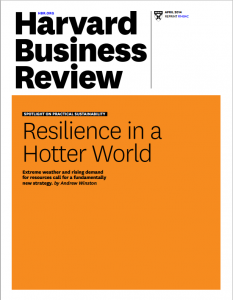Full Title: Resilience in a Hotter World
Author(s): Andrew Winston
Publisher(s): Harvard University
Publication Date: April 1, 2014
Full Text: Download Resource
Description (excerpt):
In late 2011 devastating floods struck Thailand, upending supply chains. With suppliers of critical auto parts knocked out, the production of Toyota, Honda, and other carmakers fell by hundreds of thousands of vehicles (and Toyota took an earnings hit of $1.5 billion). In October 2012, when Hurricane Sandy flooded New York, a Con Edison electric substation exploded, plunging lower Manhattan into nearly four days of darkness. The record-setting 14-foot storm surge cost the utility more than $500 million— and New York businesses a total of $6 billion. A year later, Typhoon Haiyan, reportedly the most powerful storm to ever make landfall, ravaged the Philippines, killing more than 6,000 people and causing an estimated $14 billion in damage. It’s impossible to pin any one weather event on climate change, but the scientific consensus is that as the planet gets hotter, the frequency and severity of destructive weather will only increase. Along with—and often because of—these weather patterns, we’re seeing increases in the prices of most commodities that business and society rely on. This is a sharp reversal of the trend toward lower prices that occurred during the past century. (See the exhibit “Soaring Commodity Prices.”) Major storms, droughts, and floods are cutting the supply of some renewable commodities, such as crops and clean water. Nonrenewable resources, such as oil and some metals, are also becoming scarcer. The world won’t run out of them immediately, but easily obtained, cheaper stores of them are dwindling. Meanwhile, growing populations and new wealth, particularly in China, are driving up demand for all commodities. This recently happened with cotton. As a consequence, prices for it rose 300% over one two-year period, forcing apparel makers and retailers to choose between passing along the costs to consumers, which would reduce sales, or keeping prices steady and taking a direct hit to margins. Though companies today face many global-scale challenges—from destabilizing demographic shifts to the threat of financial system collapse—extreme weather caused by climate change and increasing limits on resources are both having an unprecedented impact, threatening corporate profits and global prosperity. These “megachallenges” will require companies to fundamentally rethink their strategies and tactics.
